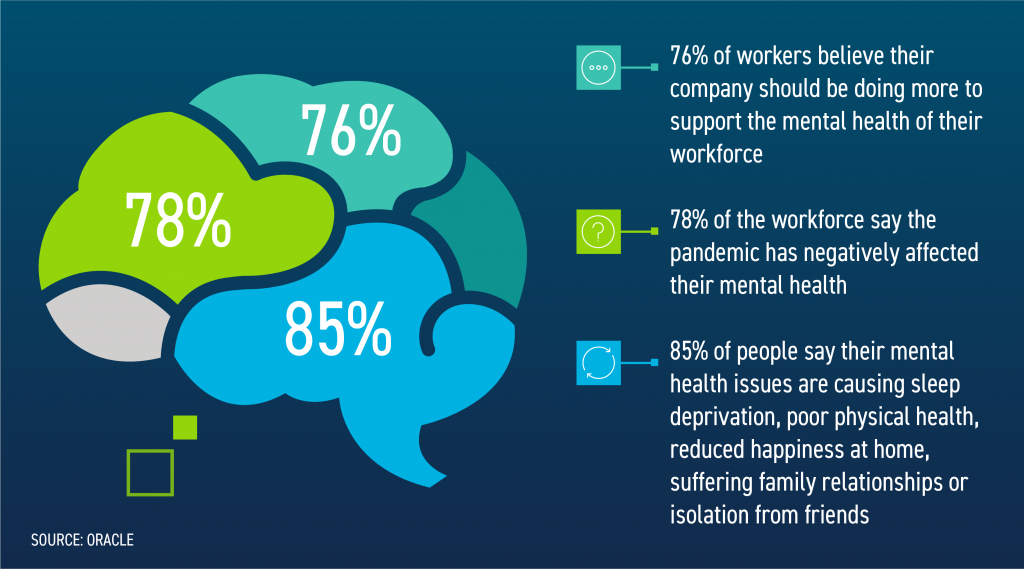While mental health in the workplace has become a hot topic in recent years, there’s no doubt some stigma still exists around discussing mental health in a professional setting. That said, with the ongoing effects of the pandemic, increased remote and flexible work arrangements, and a global blurring of lines between what constitutes home and work life, addressing mental health in the workplace has shifted from a question of “if” to “how.”
According to a report by Oracle, 76% of workers believe their company should be doing more to support the mental health of their workforce. However, while many organizations want to help employees constructively address mental health in the workplace, they often don’t know where to start.

In this article, we share tips for creating a healthy work culture, highlight warning signs to look for in employees who may be dealing with underlying mental health conditions and outline some helpful coping mechanisms. In addition, we provide resources that can be shared with employees to aid them as they continue to deal with mental stressors.
Set Guidelines to Enable Healthy Work Culture
With the rapid increase in flexible work arrangements, home and work life have seemingly blended into one, and it can be easy to forget the line where the workday ends and personal life begins. With so many employees working from home, organizations have seen an increase in worker burnout, leading to lower productivity and reduced overall satisfaction with work. So, how can leaders prevent burnout and keep employee morale high?
- Practice self-care: By taking much-needed time to manage stress, leaders will be setting a strong example for employees, leading to improved working conditions overall. Encourage your team to take plenty of breaks, eat regularly, meditate or pursue other activities they enjoy.
- Consider tone: A kind tone in an email or message can go a long way during a time of uncertainty and doubt. Without it, employees may feel discouraged to reach out when they need help.
- Communicate often: Meet with your employees regularly to check-in not only on work, but on how they are doing in general. Simply asking an employee if there’s anything they need can be extremely impactful in showing you care, especially for employees who are more hesitant to ask for help.
- Remain flexible: Remember that employees are dealing with a variety of stressors outside the bounds of work. If certain deadlines are flexible, that can be a huge relief on an employee who may be working through external factors that are taking a toll on their mental health.
- Prioritize work-life balance: Set up a designated work area away from the place you spend your downtime, set boundaries and a time you log off work for the day. Being a model for healthy work-life balance and encouraging employees to do the same is an important way to combat burnout.
Encourage Team Support
An important part of a healthy work culture is a team that supports one another. In a time where many employees are feeling overwhelmed about the same daily stressors, working together as a team to destress can prove helpful. As a leader, you can encourage teams to participate in group exercises to reduce stress. Forbes offers some suggested activities for remote teams, including group wellness programs, goal setting sessions and “Mindful Mondays.”
Additionally, to help people feel connected when physically distanced by virtual or remote work, leaders can organize team-building activities and opportunities for virtual socialization, such as:
- Interest clubs
- Informal message boards
- Trivia/game night
- Virtual happy hour
- Sharing a prompt of the day
- Video show and tell
- Book clubs
- And more!
Know the Signs of Mental Health Struggles

Even with a sound work culture in place, some employees will still struggle with underlying mental health conditions. So, how can employees, coworkers and leaders recognize the warning signs? When should employees ask for help? When should leaders offer support? Consider these assessments to take an account of current mental health states—for yourself and your colleagues.
Mental Health Assessment
If you notice some of the following warning signs in an employee or coworker, you may want to reach out and start a conversation on their mental health.
- Work Habits: Have you noticed a sudden change in an employee’s work habits? Poor productivity, minimal motivation and trouble concentrating can often be the result of a mental health concern.
- Overall Demeanor: If you notice a dramatic change in an employee’s personality, such as sudden irritability, nervousness, restlessness or other unusual behavior, this could be a sign they are struggling with their mental health.
- Increased Absenteeism: Is an employee frequently missing meetings, calling in sick or starting work late when they typically always start on time? Excessive fatigue, physical aches and overall lethargy could be associated with depression and anxiety.
- Sudden Outbursts: Employees who seem unable to control their emotions, leading to mood swings, outbursts and disruptive behavior, may be experiencing mental health concerns.
- Social Withdrawal: If an employee seems unwilling to communicate with others, avoids social interaction with other team members and purposely imposes self-isolation, this could indicate an underlying mental health concern.
Employee Self-Assessment
If an employee is experiencing several mental illness warning signs at one time, they may want to reach out to a manager or mental health professional for help. Here is a list of common signs and symptoms from the American Psychiatric Association that you can share with your employees:
- Sleep or appetite changes: Dramatic sleep and appetite changes or decline in personal care
- Mood changes: Rapid or dramatic shifts in emotions or depressed feelings
- Withdrawal: Recent social withdrawal and loss of interest in activities previously enjoyed
- Drop in functioning: An unusual drop in functioning, at school, work or social activities, such as quitting sports, failing in school or difficulty performing familiar tasks
- Problems thinking: Problems with concentration, memory or logical thought and speech that are hard to explain
- Increased sensitivity: Heightened sensitivity to sights, sounds, smells or touch; avoidance of over-stimulating situations
- Apathy: Loss of initiative or desire to participate in any activity
- Feeling disconnected: A vague feeling of being disconnected from oneself or one’s surroundings; a sense of unreality
- Illogical thinking: Unusual or exaggerated beliefs about personal powers to understand meanings or influence events; illogical or “magical” thinking typical of childhood in an adult
- Nervousness: Fear or suspiciousness of others or a strong nervous feeling
- Unusual behavior: Odd, uncharacteristic, peculiar behavior
Practice Healthy Coping Techniques
After noticing an employee may be experiencing some warning signs of a mental health issue, or after an employee approaches you for help regarding their mental health, you’ll want to approach the subject with care. Most importantly, show empathy when having conversations around mental health in the workplace. Your employee is likely feeling overwhelmed and maybe a little anxious talking in a professional setting about such a personal topic. It’s important that your employee feels comfortable sharing what they’re feeling and that you reassure them you are willing to listen and help with no fear of judgement or risk of a negative impact on their professional reputation.
Depending on the severity of the situation, you may recommend your employee see a mental health professional to talk further about their condition. However, as a starting point, you can suggest healthy coping techniques for some common mental health concerns:
Stress
Stress is a normal biological reaction to a potentially dangerous situation. When you encounter sudden stress, your brain floods your body with chemicals and hormones such as adrenaline and cortisol. Typically, after the response occurs, your body should relax. However, too much constant stress can have negative effects on your long-term health. (Healthline)
Coping with Stress:
- Emphasize work-life balance
- Exercise regularly
- Eat well
- Make time for hobbies
- Connect with a support system
- Meditate or practice yoga
- Get enough sleep
- Spend time with a pet/loved one
Anxiety
Anxiety refers to anticipation of a future concern and is associated with muscle tension and avoidance behavior. Anxiety disorders can cause people to try to avoid situations that trigger or worsen their symptoms. Job performance and personal relationships can be affected. (American Psychiatric Association)
Coping with Anxiety:
- Practice focused deep breathing
- Aromatherapy
- Take a walk
- Meditate or practice yoga
- Write down thoughts
- Identify triggers
Depression
Depression negatively affects how you feel, the way you think and how you act. Depression causes feelings of sadness and/or a loss of interest in activities you once enjoyed. It can lead to a variety of emotional and physical problems and can decrease your ability to function at work and at home. (American Psychiatric Association)
Coping with Depression:
- Stay connected with others
- Prioritize face-time (even virtually)
- Care for a pet
- Do things you enjoy (or used to)
- Try to get enough sleep
- Exercise
- Don’t skip meals
- Take a walk in the sunlight
- Challenge negative thoughts
- Read a good book/watch a funny movie
Grief
Grief is the natural reaction to loss. Grief is both a universal and a personal experience. Individual experiences of grief vary and are influenced by the nature of the loss. Some examples of loss include the death of a loved one, the ending of an important relationship, job loss, loss through theft or the loss of independence through disability. (Mayo Clinic)
Coping with Grief:
- Lean on friends and family
- Accept and face your feelings
- Express feelings creatively (writing, drawing, etc.)
- Try to maintain hobbies/interests
- Preserve memories (photo album, memorial, etc.)
- Join a support group

Additional Mental Health Resources
The tips and techniques outlined in this article are not comprehensive, but they offer a starting point for organizations who may not know how to approach the topic of mental health in the workplace—especially during such a challenging time. In addition to the strategies, assessments and coping techniques outlined above, we encourage you to share additional mental health resources with your employees, such as:




